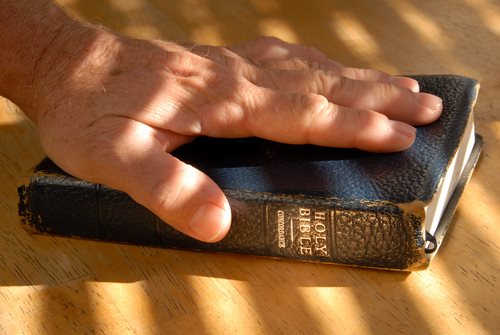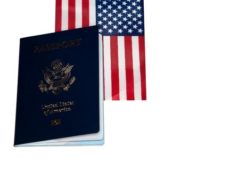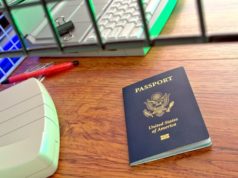 The Oath of Allegiance:
The Oath of Allegiance:
“I hereby declare, on oath,
that I absolutely and entirely renounce and abjure all allegiance and fidelity to any foreign prince, potentate, state, or sovereignty of whom or which I have heretofore been a subject or citizen;
that I will support and defend the Constitution and laws of the United States of America against all enemies, foreign and domestic; that I will bear true faith and allegiance to the same;
that I will bear arms on behalf of the United States when required by the law;
that I will perform noncombatant service in the Armed Forces of the United States when required by the law;
that I will perform work of national importance under civilian direction when required by the law; and that I take this obligation freely without any mental reservation or purpose of evasion; so help me God.”
Learn the Oath of Allegiance Here!
The Oath of Allegiance is a solemn promise that every individual who wishes to become a United States citizen must take. It is a legal and binding commitment to uphold and defend the principles and values that define the United States, including democracy, freedom, and the rule of law.
In this article, we will take a detailed look at the Oath of Allegiance and what it means for those who are eligible for citizenship. We will also explore its history, the legal implications of taking the oath, and how it has changed over time.
Why is the Oath of Allegiance Important?
The Oath of Allegiance is a foundational part of the naturalization process, a legal framework that allows non-citizens to become full-fledged members of the United States. Naturalization confers many benefits, including the right to vote, serve on juries, and hold public office. It also entails significant responsibilities, such as paying taxes, serving in the armed forces if required, and respecting the laws and customs of the United States.
The Oath of Allegiance is important because it serves as a public declaration of one’s commitment to these rights and responsibilities. It is a way for new citizens to demonstrate their loyalty to the United States and to affirm that they share its values and ideals.
What is the Oath of Allegiance?
The Oath of Allegiance is a standardized statement that all naturalization applicants must recite while raising their right hand and repeating after an immigration officer. The current version of the oath reads as follows:
I hereby declare, on oath, that I absolutely and entirely renounce and abjure all allegiance and fidelity to any foreign prince, potentate, state, or sovereignty, of whom or which I have heretofore been a subject or citizen; that I will support and defend the Constitution and laws of the United States of America against all enemies, foreign and domestic; that I will bear true faith and allegiance to the same; that I will bear arms on behalf of the United States when required by the law; that I will perform noncombatant service in the Armed Forces of the United States when required by the law; that I will perform work of national importance under civilian direction when required by the law; and that I take this obligation freely, without any mental reservation or purpose of evasion, so help me God.
This oath has evolved over time, reflecting the changing needs and values of the United States. The current version was adopted in 1952 as part of the Immigration and Nationality Act, which streamlined and standardized the process of naturalization.
Understanding the Oath of Allegiance Line By Line
Let’s take a closer look at each line of the Oath of Allegiance and what it means for new citizens:
I hereby declare, on oath, that I absolutely and entirely renounce and abjure all allegiance and fidelity to any foreign prince, potentate, state, or sovereignty, of whom or which I have heretofore been a subject or citizen;
This line requires individuals to formally relinquish any allegiance they may have held to any other country or government. It reflects the United States’ commitment to promoting full and complete loyalty to the nation and its values.
That I will support and defend the Constitution and laws of the United States of America against all enemies, foreign and domestic;
This line is a pledge to uphold and protect the foundational documents that define the United States, including the Constitution and its amendments. It also obliges new citizens to defend the country against any threats it may face, both from within and outside its borders.
That I will bear true faith and allegiance to the same;
This line is a reaffirmation of the commitment to the Constitution and its laws. It emphasizes the importance of loyalty and dedication to the United States and its values.
That I will bear arms on behalf of the United States when required by the law;
This line obliges new citizens to serve in the military if required by law. It reflects the longstanding tradition of responsible citizenship and shared sacrifice that underpins the American system.
That I will perform noncombatant service in the Armed Forces of the United States when required by the law;
This line acknowledges that not all military service involves combat. It obliges new citizens to serve in other capacities if required by law, such as providing logistical support or medical care.
That I will perform work of national importance under civilian direction when required by the law;
This line refers to the concept of national service, where individuals may be called upon to help address pressing national challenges. This could include everything from disaster relief to environmental conservation to infrastructure maintenance.
And that I take this obligation freely, without any mental reservation or purpose of evasion, so help me God.
This line affirms that the Oath of Allegiance is taken voluntarily and without reservation. It also invokes a religious element, which reflects the country’s tradition of religious freedom and diversity.
History of the Oath of Allegiance
The Oath of Allegiance has a long and storied history that reflects the changing political and social landscape of the United States. While the current version was not adopted until 1952, earlier versions can be traced back to the earliest days of the republic.
The first Oath of Allegiance was established in 1776, shortly after the Declaration of Independence was signed. This oath was a simple pledge of loyalty to the United States, and the only requirement was to support the country’s freedom and independence. New citizens were not required to relinquish any prior allegiances or swear to defend the Constitution.
Over time, the Oath of Allegiance evolved to reflect the changing times. During the Civil War, new citizens were required to swear that they had never taken up arms against the United States and that they would not do so in the future. After World War I, new citizens were required to swear that they would support the United States in any future conflicts.
The Immigration and Nationality Act of 1952 was the first major overhaul of the naturalization process since the early 1900s. Among other things, it established the current version of the Oath of Allegiance and made it a mandatory component of the naturalization process.
Recent Changes to the Oath of Allegiance
While the Oath of Allegiance has remained largely unchanged over the past several decades, there have been some recent tweaks and proposals to update it further.
One such proposal is to eliminate the religious reference at the end of the oath. Critics argue that the use of so help me God excludes non-religious individuals from fully participating in the naturalization process. Proponents, on the other hand, argue that the reference is optional and reflective of the country’s deep religious roots.
Another proposed change is to add a specific reference to the American flag. This would require new citizens to pledge allegiance not only to the Constitution but also to the Star-Spangled Banner. Proponents argue that this would reinforce the importance of national symbols and increase patriotism, while critics argue that it is unnecessary and detracts from the core commitment to the Constitution.
It remains to be seen whether these proposals will be adopted or how they would affect the Oath of Allegiance. Nonetheless, they demonstrate that the oath remains a living and evolving part of the naturalization process, reflecting the changing needs and values of the country.
Conclusion
The Oath of Allegiance is an integral part of the naturalization process, reflecting the United States’ commitment to promoting responsible citizenship, loyalty, and dedication. While its history is long and complex, the current version represents the culmination of centuries of tradition and evolution.
As applicants recite the oath, they affirm their commitment to upholding and defending the Constitution, serving the country, and contributing to its flourishing. For this reason, the Oath of Allegiance remains a powerful and symbolically rich component of the United States’ deep and storied history.






















